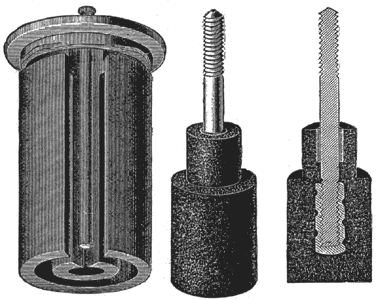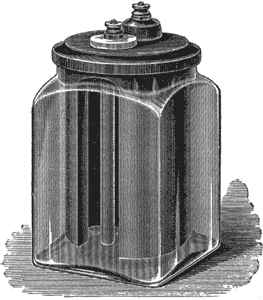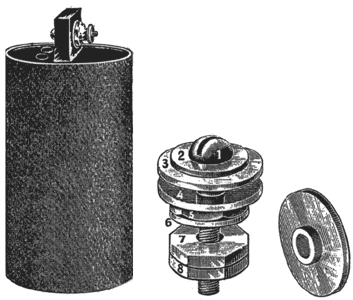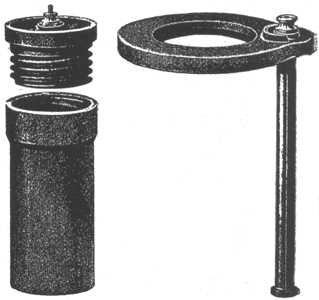[Trade Journal]
Publication: Western Electrician
Chicago, IL, United States
vol. 13, no. 6, p. 68, col. 2-3
The Law Battery.
The Law battery has been upon the market now for a time sufficient to prove by actual experience its sterling merits and its superior qualities. Fig. 1 represents the carbon and zinc employed in this battery, connected to the cover. The negative element, or Law double cylinder, is a body of carbonized material moulded in the form of a cylinder within a cylinder, weighing 25 ounces and being six inches long by 3 1/4 inches in diameter over all, thus giving a large surface
 |
| Figs. 1 and 2. the Law Battery |
for so small a body, there being 147 square inches of exposed carbon surface in this negative element. This is more than double the surface usually found in open circuit negative elements. The positive element consists of a rod of alloyed zinc and mercury, 5 1/2 inches long by 3/8 inch in diameter. The jar is of flint glass, 4 1/2 inches by 8 inches high. The cover is of material closely resembling hard rubber in appearance. The flange of the cover carries three lugs adapted to engage with small lugs on the inside of the neck of the jar. A slight turn of the cover when in place locks and seals the jar so that the solution cannot evaporate or creep out. Instead of connecting the metal post directly to the negative element a small carbon button is used into which the binding post is firmly imbedded. This button is made of hard carbon and after the binding post is placed in position the carbon button is treated to a process which drives out all the air and moisture from the carbon button and makes it impregnable to moisture. The button complete and in half is show in Fig. 2. The excitant consists of
 |
| Figs. 3, 4 and 5. the Law Battery |
five ounces of prime white granular sal ammoniac. The complete cell is 8 inches high over all, and weighs 4 3/4 pounds. The metal binding-posts are tin plated, which prevents to a great extent the unsightly appearance caused by handling the binding-posts with wet hands. The cell is especially adapted for telephone work, and for electro-therapeutical work. Fig. 3 represents a clay porous-cup element made by the Law Battery company, generally known as the "LeClanche disque." In this element the lead head has been done away with and a connection substituted which prevents corrosion at this point. By referring to Fig. 4 and 5 the parts of the connector can be understood. The washers next the screw are of pure block tin, having a centrally perforated hub projecting from one side. These hubs fit the hole in the carbon plate and project into it from the opposite sides The faces of the washers bear rigidly against the opposite faces of the carbon plate. The screw passes centrally through both of these hubs from one side of the electrode to the other. A small tinned washer is placed immediately under the head of the screw and bears against the large tinned washer. The thread end of the screw carries a nut which clamps the carbon plate and the washers securely together. Next to this nut on the screw is placed a tinned washer, then a binding nut and last a lock nut. Between the washer and the binding nut the conducting wire leading from the cell is to be clamped.
 |
| Fig. 6. the Law Battery |
Fig. 6 shows a single cylinder carbon cell also manufactured by the Law Battery company. This consists of a cylinder made integral with a cover different from other cells of this style in that the jar used is a round LeClanche jar with pour-out, and the porcelain bushing through which the zinc passes fits into this pour-out in the jar so as to prevent the carbon from turning. In other words, the cylinder is adapted to be used with a stock LeClanche disque jar. It has a special zinc and is an alloy moulded with lugs at its top which hold it in place in the porcelain bushing and away from the bottom of the jar. This cell is specially intended for bell-hangers and for that class of work where a reliable but cheap cell can be used.
Fig. 7 represents a carbon porous vessel with a screw cover. Carbon-porous cups as heretofore made for open circuit work have been filled with manganese and then permanently closed by filling or plugging with wax, which it did
 |
| Figs. 7 and 8. the Law Battery |
not pay to remove, so that when the element had lost its efficiency the depolarizing agent could not be renewed.
The illustration represents a carbon porous cup vessel in combination with a removable carbon cover. The latter being removable allows the renewal of the manganese or depolarizing agent whenever it has become exhausted or deteriorated through overwork.
Fig. 8 represents the cover carrying the zinc rod. This cover is tightened and held in place when the carbon cover is screwed into the porous cup. The screw cap is made of dense carbon subject to high pressure, the minute pores of which are sealed by a treatment which renders absorption of moisture impossible and corrosion coonsequently out of the question. A special circular zinc is made to go with this cell, which differs from the ordinary circular zinc from the fact that the zinc's stem or pencil attached to the circular zinc fits into a socket in the cylindirical zinc, and the stem on emerging from this socket is bent forward from over the carbon element as much as possible and then passes up through the surface of the liquid to and through the cover.
